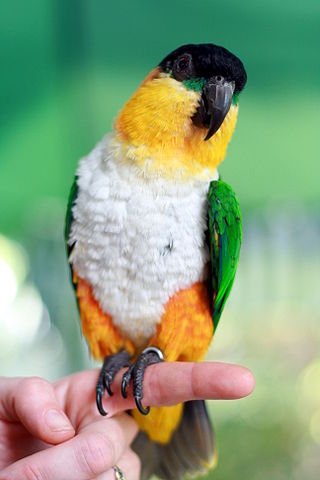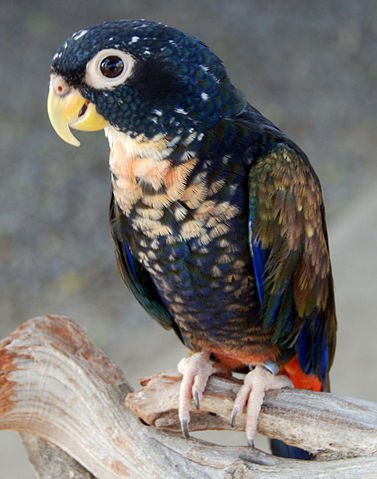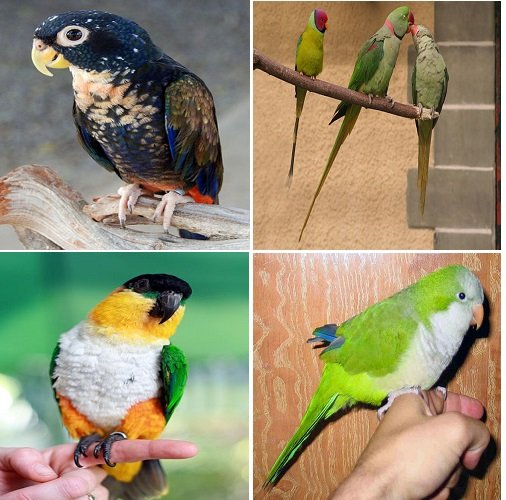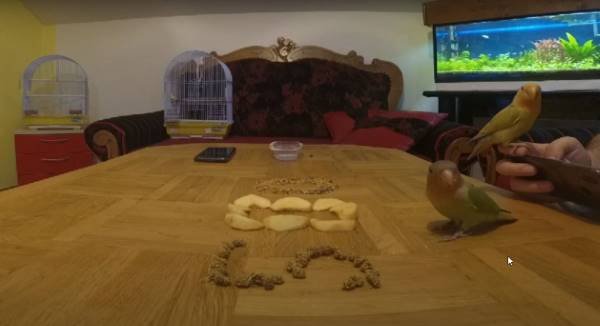This is our list of parrots that are popular, with affordable prices and easy to keep for beginners. These are top 6 beginner parrots List by parrotQuaker.com team.
6 Quaker parrots

Original in name and look, Quaker Parrots are native in South America, inhabiting a subtropical environment. They adjust well to urban conditions and humans around them. It’s widely available and affordable. However, they are much more than a practical Parrot option. They are very commercial, adorable, but also great communicators.
Quakers are dominantly green color. What makes them unique is the gray color on the head, neck, and chest. Mottled with blue beneath the wings, they have an outstanding color combination. They can live from 20 to 30 years in captivity. However, many pride themselves on even longer life expectancy. They are small, light, not too demanding in space. Around 12 inches long, weighing up to 5 ounces. They are very convenient to keep in smaller households. Quakers need space in the cage so they can play, but along with the toys, try to provide them with some materials, to satisfy their distinguished nest-building instinct.
As of the name, some say they got it because their neck looks like a Quaker’s bib. The most common opinion is that they are named after unique quaking motion when excited or irritated. Babies shake and quail for instance when they are asking for food.
Because they can be destructive when colonizing in the wild, distributing or keeping them is illegal in some states, so take your local laws into account, along with your life plans, when deciding on which parrot pet to take.
Bold and outgoing, Quakers are known to have a personality of a big bird in the small body. Excellent talking abilities are distinct features of Quakers. Not only that they can build a strong vocabulary of words and sounds, but they can pronounce clearly, and even communicate with you. So, if you need a chit-chat buddy, Quakers are a way to go.
However, they are very affectionate and easily bond with ones that care the most. This is to be taken into consideration, as they live long, and they cannot tolerate changing the environment and the owner. With Quakers, you make a long-term commitment. They are a good pet option for everyone willing to shower them in attention. Beginners can find their way around them just as well as the experienced keepers, but patience is necessary.
In this the most in-depth section you can find everything to successfully keep the Quaker. In ‘’How to Quickly Tame a Quaker Parrot’’ we present the guide to slaying this contrary to belief easy process. It’s important to understand their nature when still in the beginning, so adopting these tricks would hack the training and manner teaching for you.
If you are still unsure whether Quaker is the right choice for you, read ‘’Quaker parrot vs Other birds – Comparison’’. Taking life in your responsibility should be well thought through. After the initial excitement of having a pet pass, the reality is that ownership is not always so delightful. Read this comparison article, so you can find the one that you are compatible with.
5 Alexandrine parrot

Parrot native to forests of India and Sri Lanka is famous for its interesting history. Named after Alexander the Great, who used to keep many of them, they spread around the world and became one of the most common parrot species kept as a pet. Winning over the human heart was easy with their soft nature. As adaptable birds, they are easily trained, and therefore a great option for beginner keepers.
Predominately green, Alexandrine Parakeets shades of earthy colors, such as brick-red or mustard-yellow. If well taken care of, they can live up to 30 years. Compared to other parakeets, with 62cm in length, they are considered large.
Lovable and affectionate, these birds tend to choose their favorite human. Although social, there is often one bond stronger than the others. They have a strong personality but are not aggressive. Nevertheless, the Alexandrine parakeet is very calm. During the first interactions with the owners, they like to show off the sounds they can make. Once you get to know each other, they don’t produce a lot of noise. Naturally curious, this bird praised for centuries tries to explore the environment, to reproduce the sounds.
If you are considering getting a parrot or you just got one, read the ”Alexandrine Parakeets as Pets”. Here you can find the ultimate guide to Alexandrine nature. Aside from behavioral characteristics, the article is a useful source of information for successful keeping. The advice on cage size, feeding, entertainment, and health is provided, along with the relationship they form with other pets.
Breeding Alexandrine Parakeets is not so difficult since they are dimorphic birds, meaning that males and females are easily distinguished from one another. However, in ”Alexandrine Parrot Breeding” you can learn about the environment they need, such as breeding box or nest. Besides, understanding the mating season and baby cheeks development will help you go through this period easily.
If you want the best caretaking experience, forming them healthy eating habits should be highly prioritized. In the article ‘’Alexandrine Parrot Diet’’ you can find advice on nutrition and feeding practices both at home and in nature. When keeping a pet, it’s equally important to know what not to feed them. Especially for the first time owners, the red list of food for the Alexandrine parrot would be useful.
Alexandrines are considered royals of the parrot family. The premium one is Blue Alexandrine Parakeet. Green feathering with the unique-looking blue-gray sheen makes them extraordinary in beauty. The article ‘’Blue Alexandrine Parakeet’’ features information on the distinctive traits of the species. Breeding, Food, Health problems, and mutations are presented as the hands-on-information for keepers.
If you are considering getting a pet to keep you company, Alexandrine Parakeets are a top choice. They aren’t very demanding in care, but they do seek attention. With the long lifespan and socializing preferences, as long as you dedicate them some time, they will make great friends.
4 Caique

Often referred to as ‘’clowns of the parrot kingdom’’, Caiques are the most colorful and friskiest of all. Known to be the most playful, but also the most independent, they would make a valuable asset to your home. Native to some tropical areas of Brazile and South America, they can live from 30 to 40 years. In the language of indigenous societies of Brazile, Caique means ”aquatic bird”.
They are medium-sized parrots. Two major Caiques groups are white-headed and black-headed. Both of them have white bellies. Their colors are composed in sections of green, yellow, white, and orange. They love to socialize since, in the wild, they usually live in flocks.
In ‘’How to train Caique parrot and Caique Intelligence,’’ you can read about their tireless nature. They need to be trained early on, so their high energy levels don’t cause problems. Not only do they learn manners, but training helps their bonding process. Many people question Caique’s intelligence because they are non-talkers. However, they are a highly intelligent species. Caique can remember the range of sounds. Despite having trouble talking, a persistent owner can teach them some words or even songs, as explained in the article.
Caiques are not dimorphic, so telling the gender may be quite challenging. Knowing gender aids in the upbringing process. That’s why ‘’Caique parrot gender difference’’ features the basic tricks and facts to help you determine it. If you want to rely on professional help on this question, you can learn about the medical examinations that can be done.
When feeding Caiques, both quality and quantity are important. After reading ‘’What do Caiques eat?’’, you will learn about how to achieve the best nutrition balance suitable for their lively nature.
Although common, Black Headed Caique is not as popular as some other parrot species, mostly because of the specific caretaking they require. Unique in look, with a contrasting color palette and black-colored forehead, they are very attractive. In ‘’How to take care of Black Headed Caique,’’ we present information on their physical, behavioral, and character traits, along with tips for enjoying this nagging bird.
Another special member of Caiques family is White-bellied Caique. This subspecies, from moisty forests, faces extinction. If you would like to offer home and protection to one of them, we prepared ‘’All about White-headed Caique Care’’. Not only that they are worth attention because of being endangered. Moreover, they are very distinct in nature. They combined traits of different species. However. the common misconception is that they are hard to be taken care of. Different, with the nickname of a ‘’clown’’, they deserve the attention.
If you are a parrot lover and would love to keep more of them, make sure to check ‘’How to Caiques get along with other parrots’’ before you get your Caique’s buddy.
For a bit of entertainment, this ‘’show-bird’’ would for sure break the monotony, while being your best friend. Their great intellect, outgoing personality, and warmth, Caiques makes them a great pet option.
3 Conure

Native to locations varying from Mexico to Caribean island, they usually inhabit the western hemisphere. They are one of the most varied groups of parrots. There is a range of sizes, but they are generally small to medium. For instance, the Patagonian parrot is the largest one with 19 inches in length, while the smallest species is only 9 inches. Famous for an illuminated autumn palette of colors, with green, yellow, orange, red, brown, with some white, Conures are very attractive in looks.
With the average lifespan of around 20 years, they make great companions. Moreover, Conures have a hard immune system. That means if you provide them with optimal conditions and a balanced diet they hardly get sick. Some of the species, however, are even close to extinction.
Known as an intelligent bird, Conures are easily-trained. Even though their voice is mainly unclear, they can learn some words, but don’t pride themselves in exceptional talking ability. The voice is high-pitched which makes it difficult for us to distinguish the produced sounds.
In the wild, Conures usually live in flocks. That’s where their highly social personality comes from. They don’t fight and are consequently easy to tame. Rather curious than shy, they have an open, outgoing personality. Very affectionate, they bond with humans well, which makes them a great pet for many families. Just be patient with them, let them adjust, and you can get a ‘’real parrot’’ as they are often referred to. Why? Because they respond to the image we create of having a parrot as a pet- loveable, cuddly, evoking the attention, but cute and capable of reproducing some sounds.
They start breeding when 2 to 3 years old and breed regularly afterward. Conures are special for different mutations so in this category you can learn about many of the subspecies and its distinct features.
Green Cheek Conures are one of the family representatives widely adopted as pets. In the articles such as ‘’All about Green Cheek Conure’’ or ‘’The Green Cheek Conure Diet’’, you can find a guide to peacefully provide them with top-quality care. All the information on their roots, character, behavior, and needs are provided. Green Cheeks are famous for its numerous mutations, one of them being The Moon Cheek Conure, which also has its own caretaking guide.
From Venezuela and Brazil comes another Conure personality load. Sun Conures are amusing birds, but also one of the loudest of its size. They require dedication to be trained, a lot of affection, and attention. However, if you have some experience with Parakeet keeping, nothing is impossible. The persistent owner can tame them into a house pet very well. We got you covered with all the necessary content to make you easily pass through the initial challenge. In ‘’6 Best Toys for Sun Conure’’, or ‘’What is a good cage for Sun Conure’’, we made sure to go over all the specific house-keeping tricks to training your Conure successfully.
2 Rosellas
Rosellas come from the Southern Australian region, where they inhabit woods, gardens, and parks. They are such a valuable attribute to the landscape with vibrant colors- illuminating shades of red and purple. They can live up to 30 years.
Rosellas are small in size, but they need a lot of space. The largest cage available is the best option. They would be happiest in an aviary, but with proper setup, the cage can do as well. Easily tamed, they make a good pet choice. However, they are different from other parrots in that they don’t like the social interaction in forms of petting, cuddling, and so on. They don’t reject attention, but they just like it to be in a specific form.
They will win your heart with the whistles and chattery attitude. They can pick up some words, loving this interaction in the morning and evening.
Crimson Rosella is medium-sized, being up to 14 inches long. Their wings can reach 7.5 inches in length, however. Rosellas vary in size, but in the color combinations too. Usually, they are two to three colored species. Their cage should be wast but bar spacing kept smaller as they have smaller heads.
Crimson Rosella live peacefully with other bird of their kind, loving the freedom. In this section, you can read everything about their behavior and preferences. Articles such as ‘’Crimson Rosella behavior and care’’ are a great guide when you are at the beginning of the life together. ‘’Crimson Rosella Mutations’’, ‘’Crimson Rosella Gender Differences’’ and ‘’Crimson Rosella Breeding’’ are handy for understanding your friend to the essence.
Eastern Rosella is getting increasingly popular nowadays. With their stunning color combinations, you cannot help falling in love with them. However, not much is known about their personality. That’s why we feature ‘’Eastern Rosella Behavior’’ to help you meet your beautiful companion. Learn about their diet in the ‘’Eastern Rosella diet’’ as their original diet in the wild has to be substituted well in captivity for their best health. Knowing their gender gets them in successful breeding. This category offers thorough instructions on keeping this unique pet, so make sure to get the most out of it.
A personal favorite and favorite of many others, member of this family is The green Rosella whos living in an area stretching from Tasmania to Bass Strait Islands. She is the largest one of her family and can be easily spotted in the flock because of her light colors such as blue, yellow, green, etc.
They are attractive beings that live in the wilderness that’s pretty dense with much of western existing foods, so if you are planning to mimic their eating habits once in captivity, that’s pretty much impossible. You have to carry one thought in mind when deciding to pick the Green Rosella as your new pet, they are picky eaters!
These birds sound like a handful of work, but once you get used to it, you will be very thankful for such a companion, friend, and family member.
1 Pionus Parrot

Often neglected, Pionus is a specie of parrot native to South and Central America. They live in forests, savannas, and mountains. They are known as Red-vented parrots because they have red feathers under their short tails.
Pionus are medium-sized with up to 12 inches in length. Although they may not have bright-colors, they do look like a piece of modern art, with a wide range of colors in their plumage. As they grow, more colors are emerging and by adulthood, Pionus acquire such a beautiful appearance.
They are very easy-going birds. Although calm and quiet, they are very inquisitive. Moreover, very sweet and affectionate, they tend to bond and adapt to the household. They do want attention, however. In captivity, as in the wild, they tend to be pushed aside by the other parrots. Quite unique, they deserve adherence. Pionus are great family pets, but children should be careful. Although their bite is not as very harmful, it can get quite hard sometimes.
Not famous for their talking abilities, Pionus can obtain pretty good vocabulary. It’s not so difficult to understand them, regardless of the fact their voice isn’t completely clear. They are a great option for the apartment due to their quiet nature. However, they follow the environment. If their surrounding is noisy, they will be louder too.
As the living conditions and habitat greatly affect the Pious lifespan, make sure to read ‘’Pionus Lifespan and Diet’’ if you are keeping one. With an average of over 30 years, they make lifetime family members. It can be stretched to even 45 if well taken care of. The article features tips for proper care, with diet being an important factor in every species well-being. In order to sustain the nutrition balance that they achieve in the wild, choosing the right food is a must. This in-depth guide will explain what, why, and when they should be feed in a certain way.
The Pionus family consists of 11 members in total. In ‘’All Pionus Species’’ you can read about each species and their characteristics, along with the unique approach they require.
Pionus menstruus, commonly known as Blue-headed Pionus, born green, achieves a striking, lively colored appearance throughout their lives. They dwell in top of the trees of the tropical areas. While Enjoying their human company, they also love spending time on their own. With not as good talking ability, they can learn a few words if owners are dedicated. Not demanding, they make perfect pets, but not to everyone, however.
Blue-headed Pionus are prone to some health conditions. Vitamin-A deficiency is one of them. Aspergillosis, common avian respiratory disease, along with fungal infections and visceral gout are some of the diseases you should keep an eye on. Their exceptional life span and love seeking nature may turn away some of the owners who cannot commit to these requirements.
If you are intrigued by unknown and unusual, give Pionus the chance. You can discover together, grow, and prosper together.
Honorable mention – Budgie

One of most popular beginner parrot is Budgie or Parakeet. It is one of parrot specie that is most affordable to buy. But their lower price doesn’t make them any less of an amazing pet than others. They can be super tame and well trained. Also, budgies can learn how to talk. Not great talker thou.
Their small size, beautiful colors, and playfully nature makes them one of most popular. Still, even thou they are easy to care for they do require our full attention, nice cage size, and good quality food.






